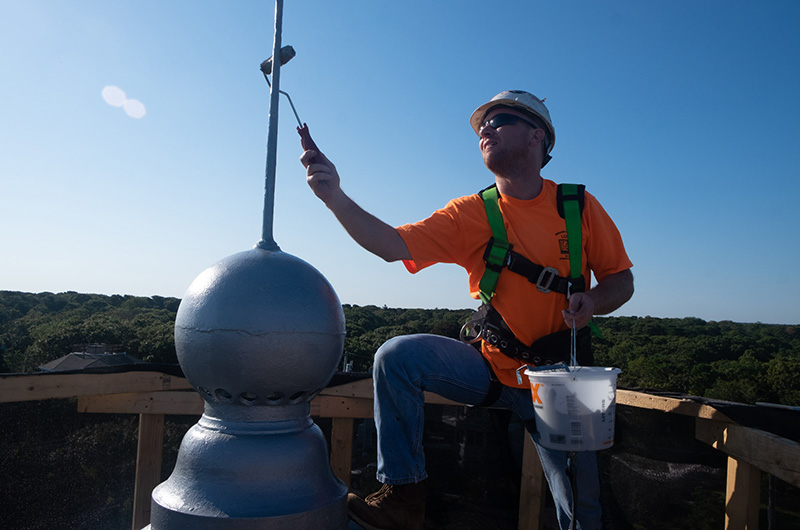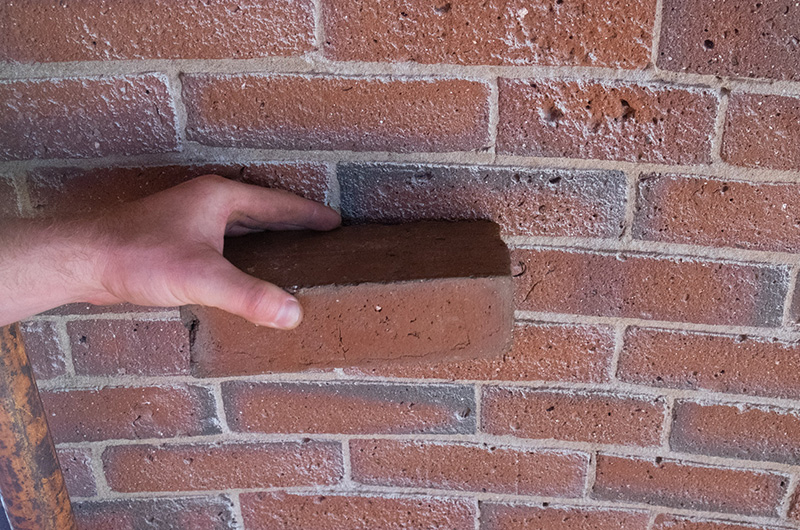Repairs are under way this fall at the East Chop Lighthouse, the historic cast-iron tower that sits on Telegraph Hill, its beacon flashing green-green-green to guide mariners on their way around the chop.

The work is being done by International Chimney, the Buffalo-area contractor that relocated the Gay Head Lighthouse in 2015 and pulled an 8,000-square-foot home back from the Wasque cliffs in 2013.
This time, there’s no need to move the structure. Built in 1878, the East Chop tower is fine where it’s been for more than 140 years — and two other lighthouses before it.
But since its last renovation in 2007, exposure to the elements has caused widespread leaks and corrosion.
“They removed a five-gallon bucket yesterday of just rust,” said Katy Fuller on Wednesday afternoon. Ms. Fuller is director of operations for the Martha’s Vineyard Museum, which manages the East Chop and Edgartown lighthouse properties.
Rob Hammett is the lighthouse keeper for East Chop, welcoming visitors at sunset on summer weekends and providing on-site support when the tower is rented out for weddings and other gatherings.
It’s an easy job compared to what lighthouse keepers had to do in the 19th and early 20th centuries, he said.
“My role is very glorified these days. I’m not trimming wicks at one in the morning. I’m not spending all night cleaning lenses, or going out in boats to rescue people,” Mr. Hammett said.
The first East Chop lighthouse — “literally, a house with just a beacon on top of it,” Mr. Hammett said — was built after the Civil War with private funds, reportedly because the federal government didn’t see the need for a second lighthouse guiding ships into Vineyard Haven when there already was one at West Chop.
Mariner Silas Daggett of Holmes Hole, who had petitioned Washington in vain, pressed ahead and raised enough money from shippers and insurance companies to build the lighthouse in 1868.
He had to do it all over again after the wooden structure burned in 1871. Mr. Daggett rebuilt the lighthouse and served as its keeper until 1875, by which time federal officials had come to see the value of protecting shipping on the vital route from Europe to the U.S. and purchased the property from him.
The first — and still only — government lighthouse at East Chop went up in 1878 at the site Mr. Daggett had picked on Telegraph Hill, so named because since 1801 a semaphore tower there was the first in a chain of 14 that signaled to mainland merchants that fresh goods from overseas were on their way to port.
“Vineyard Sound-Nantucket Sound back then was the second busiest waterway in the world,” with Vineyard Haven (Holmes Hole) harbor a key port, Mr. Hammett said.
“Any given day there’d be a hundred schooners in there,” he said, adding: “With the assistance of historic photographs, you can really understand the importance of both the East Chop and West Chop lights.”
Some time in the 1880s, the lighthouse was painted chocolate brown. It’s been white since 1988 and the beacon — a three-second green flash repeating every six seconds — was automated in 1933.
The current repair work began early this month, when the International Chimney crew arrived on the scene just after Labor Day.
The project at hand includes repairing the lighthouse lantern deck and its 12 support brackets — eight of which are cracked — as well as fixing stair supports and leaky sashes and replacing cracked windows.
“All the glass is coming out of the windows today,” Ms. Fuller said. The contractor is working to source “the right width and waviness of glass” to replace the broken panes, she added.
The lighthouse renovation is being funded entirely by Community Preservation Act funds approved by Oak Bluffs voters this year? The museum is overseeing the project.
Town assistance came after International Chimney, which regularly assesses the condition of Island lighthouses for the museum, recommended work that went “well beyond what the lighthouse fund at the museum can support,” Ms. Fuller said.
“We took it to the Oak Bluffs community preservation committee to say, we don’t feel this is maintenance. This is historic preservation,” she said.
While the museum initially proposed a two-step grant to spread out the spending, the town committee recommended funding it entirely in one year. After that, “it was the selectmen in Oak Bluffs who said this is really too important to wait.”
In April, voters agreed, approving $198,000 for the lighthouse as part of more than $1 million in CPA grants for town projects. Projected to take two months, the renovation is on track to finish by mid-November, Ms. Fuller said.
The work now underway is the first of what are expected to be two phases of renovation, Ms. Fuller said. The second phase will depend on what the contractors find as they venture between the tower’s outer hull and its interior layer of brick, on the lower levels, and beadboard above.
The $198,000 covers both the current restoration work and the cost of a full assessment to determine what remains to be done.
“We have been honest with the town that we think there’s going to be more work, but we really don’t know until we start opening it up,” Ms. Fuller said.
“This is the work we knew needed to be done . . . there will be a phase two,” for which the museum again will seek town support, she said.
And while all the Vineyard lighthouses are battered by weather from ocean storms, weekly project meetings with International Chimney have indicated that East Chop appears to be in relatively good shape, Ms. Fuller said.
“Overall, they’re telling us it’s in great condition,” she said. “It’s really good news for us to hear.”









Comments (5)
Comments
Comment policy »